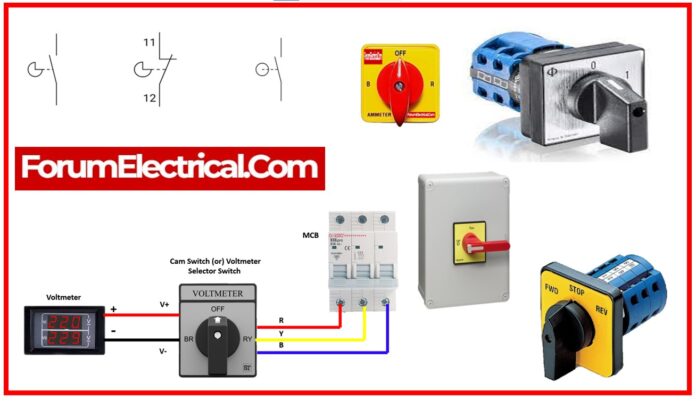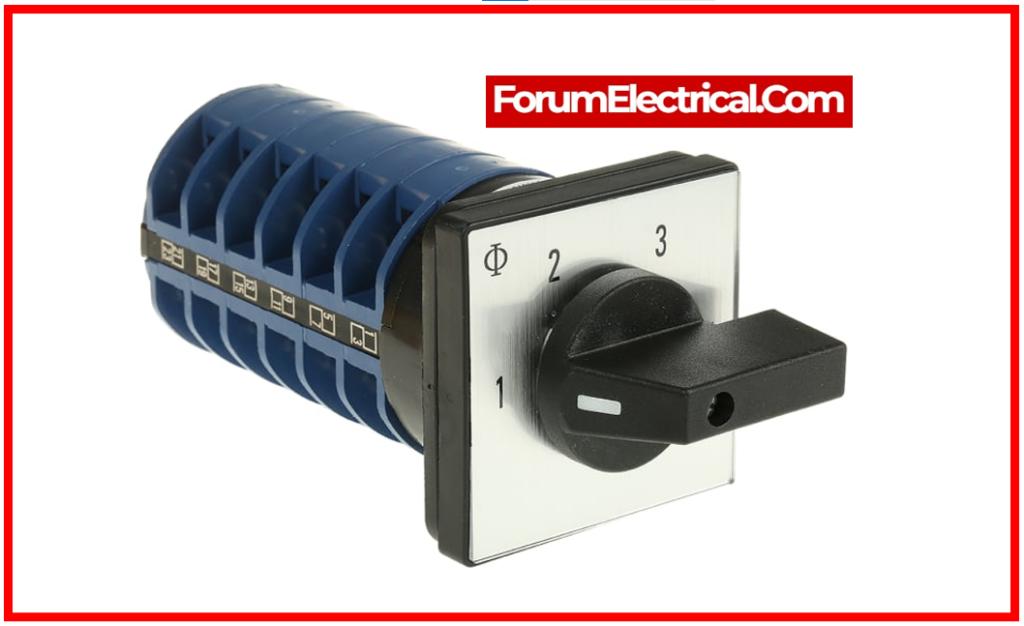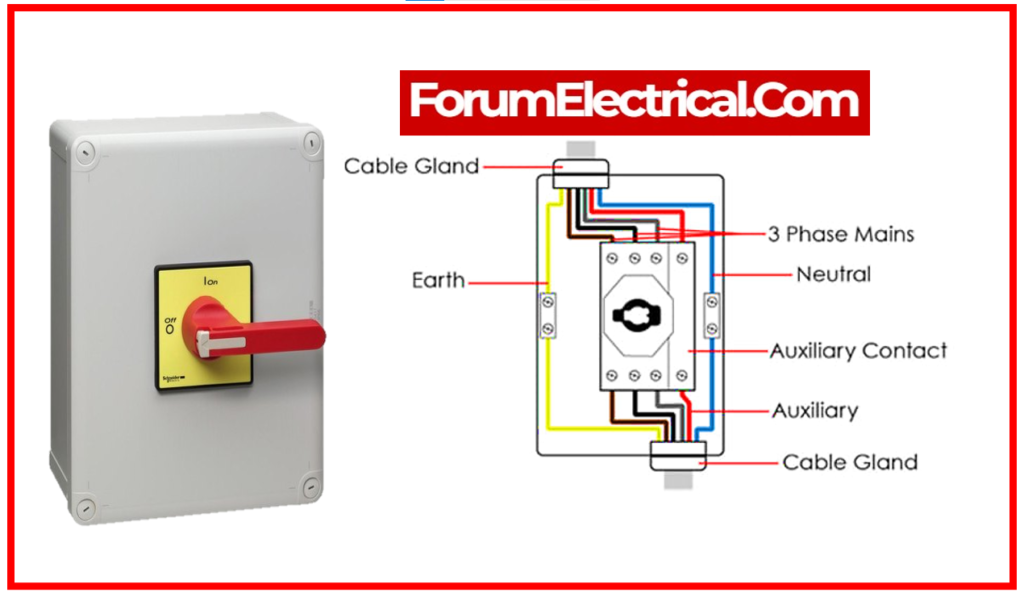- What is Cam Switch?
- Working Principle of Cam Switch
- Cam Switch Wiring Diagram
- Cam Switch Types
- 1). Multistep Switches
- 2). Isolator Switches
- 3). Voltmeter Selector Switches
- 4). Changeover Switches
- 5). Ammeter Selector Switches
- 6). Control Switches
- 7). Motor Control Switches
- Advantages of Cam Switch
- Disadvantages of Cam Switch
- Applications of Cam Switch
Cam switches are the electrical devices that are primarily used for switching in both AC and DC electrical currents, as well as for regulating motors.
These switches are made of high-quality conductive and insulating materials and are distinguished by their size, efficient switching capabilities, and so on.
Fuse linkages must be used to protect them against the short-circuit current within the circuits.
This post provides a brief description of a cam switch – how it works with applications.
What is Cam Switch?
Cam switches are used for transferring electrical energy from one end to the other by turning a handle and shaft at different angles. The handle can also be rotated to adjust the switch contacts.
The cam switch symbol is illustrated below:
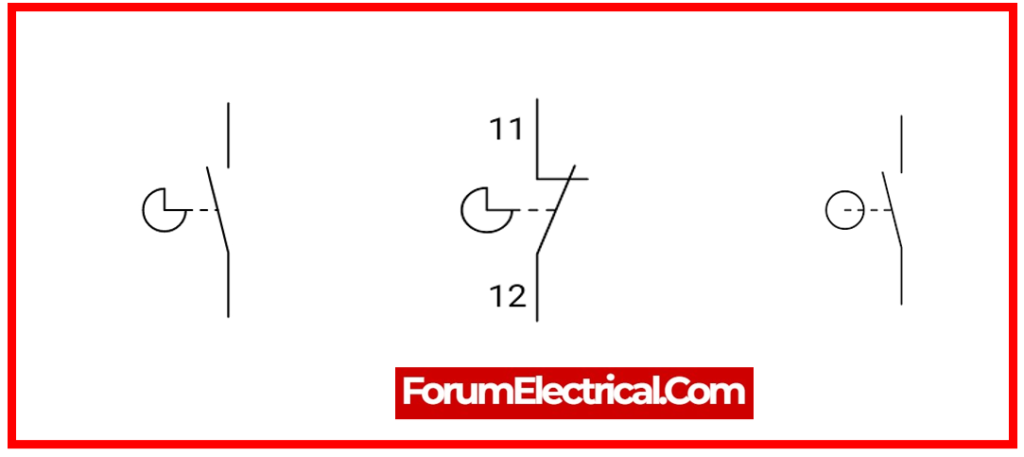
This switch is used in industrial automation to automate, control, monitor, and count operations completed by cam switches. This is a flexible device that employs a camshaft rotation to operate many switches at the same time.
Cam switches have properties such as reliable design, compact size, multi pole, quick & easy installation, and so on.
A cam switch’s operation and performance fulfill the standards defined in the IEC 60947 standard. This standard specifies the specifications for low-voltage switchgear & control gear, which includes cam switches along with additional electrical control devices.
It establishes standards for their operational qualities, electrical ratings, safety measures, & structural features. IEC 60947 compliance assures that cam switches meet the performance, safety, & reliability criteria required for effective use in a variety of electrical control applications.
Working Principle of Cam Switch
The cam switch works by sequentially making and breaking operations by turning the switch to different positions.
This type of switch rotates to numerous locations, allowing for easy control of multiple circuit operations.
Many factors must be considered while selecting this switch, including the number of contacts, locations, voltage, and poles. In this case, the switch’s number of poles and contacts merely specifies the number of functions the device can carry out.
Cam Switch Wiring Diagram
The cam switch wiring diagram is illustrated below:
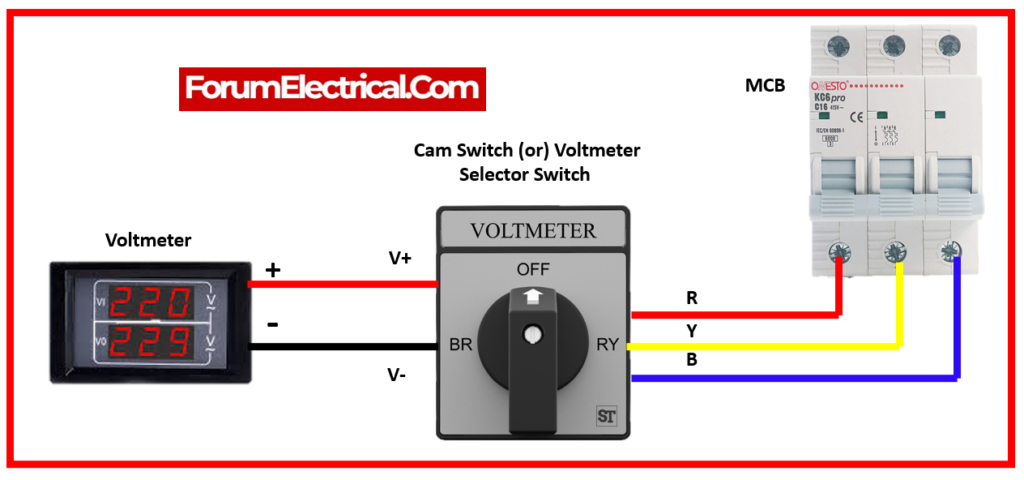
A voltmeter selector switch is the type of cam switch utilized in this circuit. Using a voltmeter, this circuit determines the voltage between three phases: RY, YB, and BR. A selector switch and a voltmeter are used for this.
This wire can be connected according to the diagram above. A voltmeter, a selector switch, & an MCB are used in this wiring connection.
The three phasing are achieved by connecting the selector switch’s R, Y, & B terminals to MCB. The voltmeter’s positive and negative connectors are connected to the switch’s V+ and V- terminals.
The circuit will be engaged once electricity is applied to the selection switch. When the switch knob is turned to the RY position, the voltage between the RY is displayed on the voltmeter.
When the switch’s knob is turned to YB, the voltage between YB is displayed on the voltmeter. When the switch knob is turned to BR, the voltage between BR is displayed on the voltmeter.
Cam Switch Types
Cam switches come in a variety of styles, including
- Multistep Switches
- Isolator Switches
- Voltmeter Selector Switches
- Changeover Switches
- Ammeter Selector Switches
- Control Switches
- Motor Control Switches
1). Multistep Switches
Multi-Step switches are utilized to link multiple circuits to a single power source. Single pole, double pole, and three pole switches are widely used in single, two, & three-phase power supply.
These switches can be utilized as a tap changing switch, especially for stabilizers or transformers, among other things.
2). Isolator Switches
Isolator switches, also known as ON-OFF switches, are primarily used to isolate power to a specific operational region.
These switches are useful for switching or controlling the main, motor ON-OFF in the instrumentation circuits, and so on.
3). Voltmeter Selector Switches
Voltmeter selector switches are mostly used to switch between phases while measuring on a three-phase system.
Furthermore, these switches measure voltages between phases as well as between phase and neutral.
4). Changeover Switches
Changeover switches are highly useful when operating two distinct circuits with different numbers of inputs and outputs. These switches are used in power supply to generator manual (or) automatic changeover, remote or automatic changeover, and so on.

These switches are frequently utilized in
- Ups,
- Distribution panels, and
- Other similar applications.
5). Ammeter Selector Switches
The ammeter selector switch is typically a three-position switch.
These switches are used to measure currents in various circuits that contain an analog ammeter, a switch, and a current transformer, or ammeters are used within each independent line to monitor current in a three-phase system.
This switch is used to reduce the number of ammeters in a three-phase system by installing current transformers on each line and connecting the output of the current transformer to the ammeter selector switch.
6). Control Switches
For an appropriate combination, a control switch with many positions can be provided.
7). Motor Control Switches
These switches are typically used to regulate two-speed forward-reverse, star-delta, and forward-reverse motors. These switches are primarily intended to be controlled by a contactor, which has an in-built tripping capability in the event of an overload or power outage.
Advantages of Cam Switch
- This switch’s functionality is simple.
- These switches are quite simple to operate.
- This switch works similarly to a transfer switch, transferring energy from one position to the another.
- It is less expensive.
- It is minimal in size.
- It does not require any maintenance.
- It is utilized in both AC and DC applications.
- It has a high level of IP security.
- This switch can be linked to either the panel door or the enclosure itself.
- It can operate at both hot and low temperatures without de-rating.
- Its installation is quicker.
- These switches have an extremely long mechanical and electrical life.
Disadvantages of Cam Switch
- This switch can only be operated physically, not remotely.
- This kind of switch is incapable of switching excessively high currents.
- It lacks any security function against magnetic and thermal currents.
- To activate it, a physical rotational power must be applied.
Applications of Cam Switch
Cam switch uses include the following applications:
- Electrical switchboards
- Electrical enclosure
- Panel builders
- Stamping machines
- Sheet metal forming machines
- Forging presses
- Presses
- Mining equipment
- Transport equipment
- Construction machinery
- Packaging machinery
- Assembly machinery
- Air conditioners
- Oil & gas.
- Auto machinery
- Wood industry
- Machine tools
- Vegetable cutting machine
- Packaging
